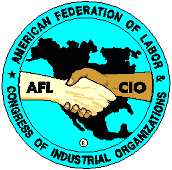Opening
Remarks
American Labor's
Second Century
Toward a Federation
of Labor
Federation of
Organized Trades & Labor Unions
A Testing Period
and Growth
Women in the Unions
Wartime Gains
and Post-War Challenges
From Murdered
Miners to Shiny Dimes
Depression, War and
A Labor Schism Healed
The AFL-CIO Years
On the Farm:
Workers Seek Equality
HOME
E-MAIL
|
|
AMERICAN
LABOR'S SECOND CENTURY
Now, in the new millennium as
the American trade union movement looks toward its second century, it
takes pride in its first "century of achievement" as it
recognizes a substantial list of goals yet to be achieved.
In this past century, American labor has played a central role in the
elevation of the American standard of living. The benefits which unions
have negotiated for their members are, in most cases, widespread in the
economy and enjoyed by millions of our fellow citizens outside the labor
movement. It is often hard to remember that what we take for
granted-vacations with pay, pensions, health and welfare protection,
grievance and arbitration
procedures, holidays never existed on any meaningful scale until unions
fought and won them for working people.
Through these decades, the labor movement has constantly reached out to
groups in the American society striving for their share of opportunity
and rewards..... to the blacks, the Hispanics and other minorities.....
to women striving for jobs and equal or comparable pay . . . to those
who work for better schools, for the freedom of speech, press and
assembly guaranteed by the Bill of Rights ... to those seeking to make
our cities more livable or our rural recreation areas more available . .
. to those seeking better health for infants and more secure status for
the elderly.
Through these decades, in addition, the unions of America have
functioned in an economy and a technology marked by awesome change. When
the
Federation of Organized Trades and Labor Unions gathered in convention
in 1881, Edison had two years earlier invented the electric light, and
the first telephone conversation had taken place just five years before.
There were no autos, no airplanes, no radio, no television, no air
conditioning, no computers or calculators, no electronic games.
For our modest energy needs-coal, kerosene and candles-we were
independently self-sufficient.
The labor movement has seen old industries die (horse-shoeing was once a
major occupation) and new industries mature. The American
workforce, once
predominantly "blue collar," now finds "white
collar" employees and the "grey collar" people of the
service industries in a substantial majority. The workforce in big
mass production industries has contracted, and the new industries have
required employees with different skills in different locations.
Work once performed in the United States has been moved to other
countries, often at wage levels far below the American standards.
Multinational, conglomerate corporations have moved operations around
the globe as if it were a mammoth chessboard. The once thriving
U.S. merchant marine has
shriveled.
A new kind of "growth industry"-consultants to management
skilled in the use of every legal loophole that can frustrate union
organizing, the winning of
representation elections, or the negotiation of a fair and equitable
collective bargaining agreement-has mushroomed in recent years, and
threatens the stability of labor-management relationships. A group
of organizations generally described as the "new right" enlist
their followers in retrogressive crusades to develop an anti-union
atmosphere in the nation, and to repeal or mutilate various social and
economic programs that have brought a greater degree of security and
peace of mind to the millions of American wage earners in the middle and
lower economic brackets.
Resistance to modest proposals like the labor law reform bill of 1977,
and the use of lie detectors and electronic surveillance in probing the
attitudes and actions of employees are a reminder that opposition to
unions, while changing in style from the practices of a few decades ago,
is still alive and flourishing often financed by corporate groups, trade
associations and extremist ideologues.
Yet through this dizzying process of change, one need remains
constant-the need for individual employees to enjoy their human rights
and dignity, and to have the power to band together to achieve equal
collective status in dealing with multi-million and multi-billion dollar
corporations. In other words, there is no substitute for the labor
union.
American labor's responsibility in its second century is to adjust to
the new conditions, so that it may achieve optimum ability to represent
its members and contribute to the evolutionary progress of the American
democratic society.
AFL-CIO President Lane Kirkland expressed that concept in his formal
statement on labor's centennial in 1981:
"Labor has a unique role in strengthening contemporary American
society and dealing adequately and forcefully with the challenge of the
future."
"We shall rededicate ourselves to the sound principle of harnessing
democratic tradition and trade union heritage with the necessity of
reaching out for new and better ways to serve all working people and the
entire nation."
Back to
Top
[Home]
[373
Officers] [Upcoming
Events] [Links
to Other Unions]
[Local
373 E-mail] [Webmaster
E-mail] [373
Members E-mail Directory]
[Ironworkers'
Prayer] [History
of American Labor]
[Sign
Guestbook] [View
Guestbook] |

